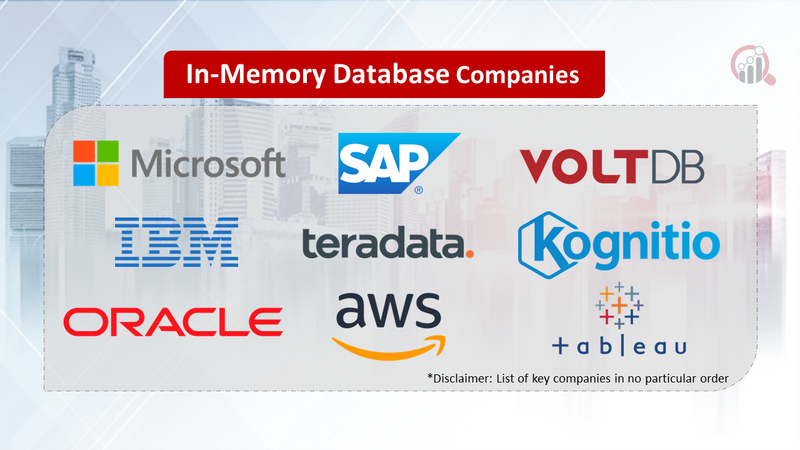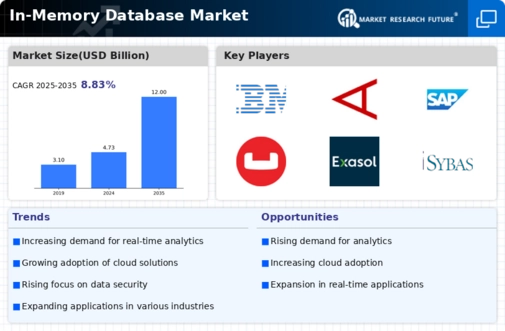Top Industry Leaders in the In Memory Database Market

Competitive Landscape of the In-Memory Database Market:
The in-memory database market is a dynamic space, characterized by rapid growth and intense competition. In this context, understanding the competitive landscape is crucial for both established players and new entrants.
Key Players:
- Microsoft Corporation (US)
- IBM Corporation (US)
- Oracle Corporation (US)
- SAP SE (Germany)
- Teradata Corporation (US)
Strategies Adopted:
- Product Differentiation:Players are constantly innovating to differentiate their offerings. IBM, for example, emphasizes its hybrid in-memory capabilities, while Microsoft touts its seamless integration with Azure cloud platform. Niche players like MemSQL focus on specific use cases like fraud detection and real-time analytics.
- Cloud-Based Deployment:The shift towards cloud computing is a major trend, with players offering in-memory database solutions as managed services. This simplifies deployment and reduces infrastructure costs for users.
- Partnerships and Acquisitions:Strategic partnerships and acquisitions are common, allowing players to expand their reach and acquire new technologies. For instance, Microsoft partnered with SAP for in-memory data management in SAP HANA.
- Open-Source Initiatives:Open-source in-memory databases like Apache Ignite and Cassandra are gaining traction, attracting developers and offering cost-effective alternatives.
Factors for Market Share Analysis:
- Product Portfolio:The breadth and depth of a vendor's in-memory database offerings, including support for different data types and functionalities, is crucial.
- Customer Base:Having a strong customer base, especially in key verticals like finance, healthcare, and telecommunications, translates to higher market share.
- Brand Reputation:Established brands like IBM and Oracle enjoy an advantage due to their long-standing reputation and trust among customers.
- Geographical Presence:Global presence and strong regional partnerships are important for catering to diverse customer needs across different markets.
- Technology Innovation:Continuous investment in R&D and development of cutting-edge features like real-time analytics and AI integration are key differentiators.
New and Emerging Companies:
- MemSQL:Focused on high-performance in-memory databases for real-time analytics, especially in fraud detection and risk management.
- Redis Labs:Offers a NoSQL in-memory database known for its fast performance and scalability, popular in web applications and caching.
- Aerospike:Specializes in hybrid in-memory databases, optimized for flash storage and latency-sensitive applications.
- Couchbase:Provides a distributed in-memory database platform with a focus on scalability and ease of deployment.
Current Investment Trends:
- Cloud-Native In-Memory Databases:Players are investing heavily in developing in-memory databases specifically designed for cloud environments, with features like automatic scaling and elastic pricing.
- Hybrid In-Memory Solutions:Combining the speed of in-memory with the cost-effectiveness of disk-based storage is a key focus area, catering to a broader market segment.
- Artificial Intelligence Integration:Embedding AI capabilities like machine learning and real-time analytics into in-memory databases is gaining traction, enabling predictive maintenance and fraud detection.
- Open-Source Collaboration:Increased contributions to open-source in-memory database projects like Apache Ignite are fostering innovation and attracting a wider developer community.
Latest Company Updates:
December 15, 2023, MemSQL announces a strategic partnership with Google Cloud to deliver a high-performance in-memory database service on GCP.
December 12, 2023, Redis Labs launches a new version of its flagship in-memory database platform, Redis Enterprise 8.0, featuring enhanced security and performance.
December 5, 2023, SAP HANA Cloud receives the SOC 2 Type 2 certification, demonstrating its commitment to data security and compliance.
November 29, 2023, VoltDB announces a collaboration with NVIDIA to optimize its in-memory database for AI and machine learning workloads on NVIDIA GPUs.









